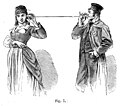Micrographia: or Some Physiological Descriptions of Minute Bodies Made by Magnifying Glasses. With Observations and Inquiries Thereupon is a historically...
8 KB (902 words) - 14:57, 29 June 2024
Micrographia is an acquired disorder characterized by abnormally small, cramped handwriting. It is commonly associated with neurodegenerative disorders...
4 KB (404 words) - 17:16, 28 May 2024
Hooke identified the rotations of Mars and Jupiter. Hooke's 1665 book Micrographia, in which he coined the term cell, encouraged microscopic investigations...
90 KB (10,829 words) - 13:38, 3 September 2024
depicted in Micrographia The cell was first discovered by Robert Hooke in 1665, which can be found to be described in his book Micrographia. In this book...
26 KB (3,347 words) - 15:33, 29 August 2024
drops and describe experiments performed. Among these publications was Micrographia of 1665 by Robert Hooke, who later would discover Hooke's Law. His publication...
20 KB (2,334 words) - 16:36, 3 July 2024
the term cell (from Latin cellula, meaning "small room") in his book Micrographia (1665). 1839: Theodor Schwann and Matthias Jakob Schleiden elucidated...
60 KB (6,271 words) - 04:42, 20 August 2024
An engraving of the cells of cork, from Robert Hooke's Micrographia, 1665...
137 KB (14,760 words) - 21:23, 26 August 2024
early subjects of microscopy, appearing in Robert Hooke's 1667 book, Micrographia. Lice are divided into two groups: sucking lice, which obtain their nourishment...
42 KB (4,658 words) - 22:34, 4 July 2024
Drawing from Robert Hooke's Micrographia of the compound eye of a grey drone fly...
10 KB (1,217 words) - 08:24, 26 July 2024
Schröter (1791), extending its previous use with volcanoes. Robert Hooke in Micrographia (1665) proposed two hypotheses for lunar crater formation: one, that...
21 KB (1,989 words) - 21:33, 11 May 2024
the microscope by the English polymath Robert Hooke. In his 1665 book Micrographia, he stated that far from being spontaneously generated from dirt, they...
47 KB (4,996 words) - 11:03, 17 August 2024
plants in the United States Diagram of a plume moth from Robert Hooke's Micrographia Leaf-shaped moth (Pergesa acteus) Giant grey moth (Agrius convolvuli)...
31 KB (3,115 words) - 19:20, 28 August 2024
the oscillations of a pendulum. In 1657, Robert Hooke published his Micrographia, in which he hypothesised that the Moon must have its own gravity. In...
74 KB (7,488 words) - 00:33, 27 August 2024
efficient optical switches and low-reflectance glass. In his 1665 book Micrographia, Robert Hooke described the "fantastical" colours of the peacock's feathers:...
42 KB (4,594 words) - 16:12, 16 August 2024
shark. Robert Hooke (1635–1703) included micrographs of fossils in his Micrographia and was among the first to observe fossil forams. His observations on...
111 KB (11,445 words) - 17:40, 29 August 2024
has been understood in general terms since Robert Hooke's 1665 book Micrographia, where Hooke correctly noted that since the iridescence of a peacock's...
20 KB (1,969 words) - 08:25, 29 June 2024
life in the form of the fruiting bodies of moulds. In his 1665 book Micrographia, he made drawings of studies, and he coined the term cell. Louis Pasteur...
74 KB (7,754 words) - 23:03, 28 August 2024
to Micrographia (1665) «I have, by the help of a distended wire, propagated the sound to a very considerable distance in an instant». Micrographia - Extracts...
7 KB (796 words) - 20:02, 28 July 2024
Hooke's drawing of a flea under the microscope in his pioneering book Micrographia published in 1665, poems by Donne and Jonathan Swift, works of music...
44 KB (4,680 words) - 07:00, 19 August 2024
Imprimerie de Ian Maire. ISBN 978-0-268-00870-3. Hooke, Robert (1667). Micrographia: or some physiological descriptions of minute bodies made by magnifying...
107 KB (11,683 words) - 10:54, 17 August 2024
compared the spreading of light to that of waves in water in his 1665 work Micrographia ("Observation IX"). In 1672 Hooke suggested that light's vibrations could...
51 KB (6,346 words) - 23:00, 17 August 2024
In 1663–1664, the English scientist Robert Hooke was writing his book Micrographia (1666) in which he discussed, among other things, the relation between...
27 KB (3,361 words) - 20:09, 1 September 2024
A study of an egg of a silkworm from Hooke's Micrographia, 1665...
38 KB (4,357 words) - 01:32, 23 August 2024
Image of a flea from Robert Hooke's Micrographia (1665), a Royal Society work...
58 KB (7,966 words) - 15:54, 31 August 2024
structures with the lungs. The publication in 1665 of Robert Hooke's Micrographia had a huge impact, largely because of its impressive illustrations. Hooke...
31 KB (3,699 words) - 15:02, 20 May 2024
on booklice. Robert Hooke referred to a "Land-Crab" in his 1665 work Micrographia. Another reference in the 1780s, when George Adams wrote of "a lobster-insect...
26 KB (2,165 words) - 00:31, 25 August 2024
the building blocks of all living organisms as "cells" (published in Micrographia) after looking at a piece of cork and observing a cell-like structure;...
41 KB (5,249 words) - 22:04, 17 August 2024
(2008), Science, Evolution, and Creationism. Hooke, Robert (1635–1703). Micrographia, Observation XVIII. See Acid–base reaction. See, for example, Common...
54 KB (6,932 words) - 19:46, 31 August 2024
fluid. Orpiment is mentioned in the 17th century by Robert Hooke in Micrographia for the manufacture of small shot. Scientists like Richard Adolf Zsigmondy...
19 KB (1,795 words) - 02:52, 14 May 2024



























